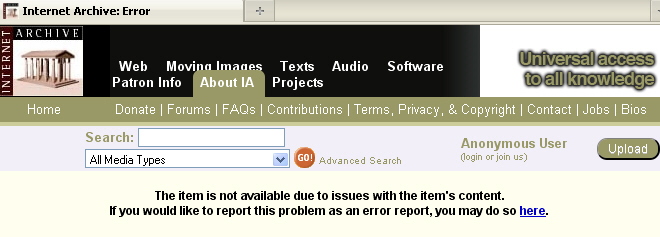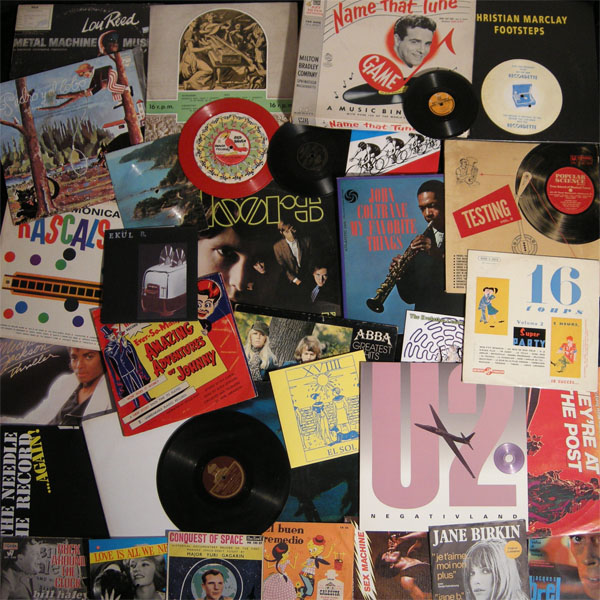"this is the end, beautiful friend" censorship affair
At the end of September 2010, the album "This Is The End, Beautiful Friend", by File Under Toner, was "made unavailable" by the Internet Archive due to "issues with the item's content" and was replaced by the following screen:
http://www.archive.org/details/hr061
The Internet Archive is a non-profit digital library which offers permanent storage and access to collections of digitized materials, including websites, music, moving images, and books. Its stated mission is: "Universal access to all knowledge". Hazard Records is a netlabel hosted (among some 1500 other labels) in the "Netlabels" section of the Internet Archive since June 2004. When we (Hazard Records) moved all our files into the Internet Archive we let them know explicitly that some of our releases might deal with appropriation, since we did not want to cause trouble to the Archive. The staff at the Internet Archive let us know that this was not a problem for them.In august 2008, Hazard Records released the album "This Is The End, Beautiful Friend", by File Under Toner (a pseudonym Anki Toner uses for some projects) and uploaded it to the Internet Archive (as had done with its 60 previous releases). The record has thus been hosted at the Internet Archive during two years, without problems. This album, and all other albums released by Hazard Records, is in the Public Domain.
"This Is The End, Beautiful Friend" was made by recording run-out grooves (supposedly silent) of thirty-six selected records and manipulating them both by analogue and digital means (mainly by playing them on vari-speed turntables and adding delay, echo and reverberation). The audible result is a series of thirty-six short tracks of manipulated surface noise (mostly pops, cracks and hiss).
The selection of source material was made following three or four basic criteria, addressing issues such as turntablism, clicks & cuts, silence, indeterminacy, originality, authorship, appropriation, intellectual property, history of sound reproduction technologies, record collecting, concept albums, fetichism, gramophony...
The first of such criteria was format. The records used were mostly vinyl, but also shellac, cardboard, and even less usual formats, looking for a different "grain" in the original sound.
Another important factor was personal relationship with the record. Some of the records used are among the author's favourite records, or maybe he has had them since he was a child...
Finally, some of the records were chosen for "political" reasons. This record poses a couple of questions: "do the silent run-out grooves have copyrights?" and "in case they have, who do they belong to?". For this reason, it uses records from artists who have been involved in copyright infringement cases before. We have used run-out grooves of records by Abba, Michael Jackson and James Brown, all of them known for suing artists who had used fragment of their works out of context. We have also used the run-out groove of one of the few surviving copies of Negativland's "U2" record (almost all the copies of which -masters included- were destroyed for copyright infringement).
Of course, none of this would make much sense if the source of each silent run-out groove was not clearly explained in the liner notes.
But these are strange times, and explaining too much can be troublesome. According to the US law (and we must remember here that the Internet Archives servers are on US soil), Internet Service Providers are not liable of copyright infringement if they do not have actual knowledge that they are hosting infringing material, but they must act as soon as they are notified of a possible infringement, or else they risk being prosecuted. This means that any person claiming to be (or to act in the name of) a copyright owner can notify a copyright infringement and possibly have a file removed from the Internet, without need that a judge, court or jury sees the case.
The Internet Archive, specially in sections such as Community Audio, runs the risk that some users upload copyright infringing files (and, what is worse, for reasons quite far from the Archive's stated mission). In fact, some users do. We understand that they are forced to "make unavailable" a number of files. They probably spend much more time and effort on that task that they would want to.
However, what is discouraging in this case is that since the record was "made unavailable", no one at the Internet Archive has answered our emails, posts in forums or even this open letter:
http://www.archive.org/post/326909/this-is-the-end-beautiful-friend-made-unavailable-at-the-internet-archive
This is strange, since our experience with the Internet Archive staff has always been very positive in the past. They have always been helpful and quick to answer.Nevertheless, at Hazard Records we believe that all this nonsense is a consequence of the pressure that receives any institution that tries to enlarge the borders of free culture, like the Internet Archive does. This battle is being tough, since questioning copyright (even, not reclaiming one's possible copyright and placing works in the Public Domain) represents attacking capitalism itself.
That is why we have decided to assume that this record has been "made unavailable" by mistake, detected by some robot or caught in some sort of automatic copyright infringement filter. We do not believe that the Internet Archive is interested of getting rid of this or any similar work (while the opposite might be true), though they probably have their hands tied in these situations.
So, we have un-censored the record (made it available again) in October 2010. Just to (try to) keep things calm, we have removed (part of) the liner notes and replaced them by the open letter we wrote to the Internet Archive. The original liner notes can still be found in a text file (hopefully invisible for automatic filters). We hope that this is a good solution for this situation. However, it might be a good idea to download the record quickly, just in case.
You will find the record here:: http://www.archive.org/details/hr061b
-----------------------------------------------------------------
SUPPOSEDLY OFFENDING LINER NOTES:
-----------------------------------------------------------------
recording the silent final grooves of records. not so silent after all. playing them loud enough to capture the hiss, the pops, the clicks. adding a couple of digital delays, some EQ and filtering, a little reverb here and there… not much, really. it’s all in the records if you know where to listen.
of course it is difficult to listen to these grooves with automatic return turntables (stupid consumer-oriented machines). maybe that’s why you never paid attention.
you will probably have to raise the volume to play this album, which will add a little electronic hum, different with every equipment on which you play it. this is a (nice) feature, not a bug.
if you have the means, stamp these tracks on a three sided LP. you will have three free extra end grooves, and a blank side to needle-surf.
one last thing. probably some people will think this is not legal, i should not be allowed to do this, i am stealing somebody else’s copyrights (john cage’s?), etc...
nevermind, most people will just think this is not music.
SIDE A
THE BEGINNING, ACTUALLY The Doors “The Doors” (Elektra, 33 rpm, side B, 500-71SB1). This is the end, beautiful friend, of The Doors first album. And it is the beginning of mine, which is not the first, anyway (but is the last so far –at the time of writing this-, of course). What a coincidence.
FAVORITES John Coltrane “My Favorite Things” (Atlantic, 33 rpm, side A, ST A 60303 D). Well, yes, let’s admit it, these are some of my favorite records. That’s why I chose them.
AND WHO GIVES A SHIT Negativland “U2 – 1991 A Cappella Mix” (SST, 45 rpm, side A, SST272A). As you all know, this record does not exist. All copies were destroyed after Island/Warner sued Negativland. Everyone who had received a copy of the record -reviewers, record stores, radio stations, etc.- was notified to return it. (If they failed to comply, they might be subject to penalties which might include imprisonment and fines). Once returned, the records were forwarded to Island for destruction. Nevertheless, this track has been recorded from one of the remaining copies of the original 1991 SST edition. Thanks, Vicenc and Esther!
SPEEDMETAL MACHINE MUSIC Lou Reed “Metal Machine Music” (RCA, played at 78 rpm, side A, CPL-2-1101-A-1). Not the non-silent locked groove at the end of side four, of course, but the supposedly silent locked groove at the end of side one.
LET ME DIE IN YOUR FOOTSTEPS Christian Marclay “Footsteps” (Rec Rec Music, 45 rpm, 26A-LC7981). Christian is one of the guys who taught us how to listen to records. When I got this record, it was SO dirty I did not dare to play it for a while, afraid it might damage my precious equipment. It probably did, and probably that was what it needed.
SURF ACE NOISE The Beach Boys “Surf’s Up” (CBS,33 rpm, side B, S CRB 32085 / CBS 31774B2). This is one of these records that is better every time you listen to it. The final groove is better every time too.
THRILLERPHONICS Michael Jackson “Thriller” (EPIC /CBS, 33 rpm, side A, 85930A). Free samples, blank tape is derivative, nothing of itself, the commerce of noise, chimeras of sound, starting from scratch, the medium is magnetic, aural wilderness, the buzzing of a titanic bumblebee.
MAGIC The Magic Record Album (Atlantic Records, 78 rpm, parallel grooves, side A, 114-A) Double 10-inch record with parallel grooves. It plays a different story each time, in total 256 different stories! You don’t need to wait for the final groove to get some randomness, but you can still do. It depends on what you are looking for.
HIGH FIDELITY Popular Science Monthly “Testing Vol. 2” (Urania, 33 rpm, side A, UPS-2B). This 1957 LP is subtitled “True Sound Of Musical Tones” and is supposed to “prove your system’s true high-fidelity”. By the way, the Urania label made some of the best cover art ever.
PARTY v.a. “16 Tours Super Party vol. 2” (Ducretet Thompson, 16 rpm, side A, 620V003A). I always wondered what was the use of the “16 rpm” position in a record player until Anton Ignorant gave me this record. If I remember well I gave him a Spanish-Russian dictionnary in exchange.
ORGY Orquesta Salvador “Orgie” (Odeonette, 6 inch shellac disc, played at 115 rpm, side A, 30003a). Older records are usually referred to as “78s”, but they were recorded at any speed between 70 and 100 rpm. For this Orgie I chose 115rpm, which is as fast as I could spin.
SEX MACHINE James Brown “(Get Up I Feel Like Being A) Sex Machine” (Polydor, 45 rpm, side A, 2001071A) We all know what the late great J.B. tought of people who sampled him: he sued them. And probably there is someone who still does. It is interesting to note that, since the complete Sex Machine track spans over the two sides of this single, what I recorded (end of side A) is actually in the middle of the song.
SIDE B
JUSTIFIED Abba “Greatest Hits” (EPIC, 33 rpm, side A, SEPC69218A). This one is absolutely justified, isn’t it?
MOI NON PLUS Jane Birkin & Serge Gainsbourg “Je t’aime… moi non plus” (Golden 12, 45 rpm, side A, G12/88A). A masterpiece too frequently mistaken for a novelty record. Years ago we used the piano part in a song. Later I used part of the lyrics in another. Why should’t I use the final silent groove now? By the way, this is the german edition of the single.
FAHR FAR FUN Kraftwerk “Tour de France” (EMI, 45rpm, side A, 1C006 1652047A). The end of side A of the 45 rpm french edition of the single. But this is the side with the german lyrics, as you probably guessed.
NAME THAT TUNE Name That Tune Game (Milton Bradley Co.,33 rpm, side A, TV26965-1A). This game is a music bingo. One player is the “disk jockey” and plays the record randomly. The other players receive a card each with song names and have to guess the tunes. The first player to complete a row (five tunes) on his card wins the game. I guess they never guess this one.
HOWLIN’ WOLF Serge Prokofiev “Pedro y el lobo” (Philips, 33 rpm, side B, P13168 2L). This record belonged to my parents. I liked it when I was a kid, but I find the drawing of the wolf so scary I could not even look at it. Sometimes I am still scared if I hear the Peter And The Wolf tune unexpectedly.
SARDANA Cobla Catalana. El Sartiró de la Cardina (Fonoscope sound postcard, 45 rpm, c43-M287). Cardboard record postcard sent by my mother to her parents and sister on july 12, 1960. It promises “200 perfect auditions”. This is the 199th.
HARMONICA The Harmonica Rascals “The Harmonica Rascals” (International Award Series, 33 rpm, side B, AKS-177B). Harmonica is the only instrument I can play, so I included a harmonica record. They also crackle.
VIOLINS Mendelsohn/Tchaikowsky “Concert(s) for Violin and Orchestra” (Club Internacional del Disco, 16 rpm, side A, CID-301614-A-1) Another 16 rpm record. I was missing some classical music in this collection.
FLY ME TO THE MOON Conquest Of Space (BriTone, 45 rpm, side A, MK100EP/BM7453). This is a historical documentary record of the first manned space-orbit flight by Major Yuri Gagarin, a 1961 british edition of the USSR recording. The original sound recording has so many crackles, and the actual record is so used (by my parents on a merciless 60s portable player) that I could have recorded any part of the record with the same effect.
HELLO DOLLY Doll Record no-25 (Jesmar, 115 rpm, parallel grooves) This 2-inch doll record was a present from Ajo. It is so small that I had to buid a special adapter to be able to play it. And it should have played a little faster (maybe around 120) but I could not spin that fast.
ROCK AROUND THE CLICK Bill Haley and the Comets “Rock Around The Clock” (Warner Bros, 45 rpm, side A, WV5102/45.5102.A). I could simply not resist the pun. Sorry.
LA VALSE À MILLE ECHOS Jacques Brel “La valse à mille temps” (Philips, 33 rpm, side B, AA 432371 2E). Brel is incredible. Let’s waltz to a thousand echoes.
SIDE C
AGAIN Criminal Element Orchestra “Put The Needle On The Record… Again!” (BCM Records, 45 rpm, side B, DM-C0397B). It would rather be “don’t take the needle out of the record” but it’s ok if you put it back.
TYPEWRITING La Garde Républiquaine de Paris. “La Nouba - Marche Afriquaine” (Gramophone and Typewriter Ltd. And Sister Companies, 78 rpm, 30009X) This one sided shellac disc is the oldest record in this collection (probably dating from around 1905). In it, the French “Garde Républiquaine” band is trying to play an african rhythm. They miss the spot, at least from a XXIst century point of view, but they play a strangely relaxed repetitive rhythm which turns out to be quite beautiful.
SI LOS CURAS Marcos Redondo con banda y coro. “Himno de Riego” (Odeon, 80+ rpm, side A, 184238A). El Himno de Riego has been the national anthem of Spain during the Trienio Liberal and the First and Second Spanish Republics. It was banned during the Franco regime and we used to sing it clandestinely.
HORSES “They’re At The Post” (Homestead Records, parallel grooves, 33rpm, 1011). This is a phonofinish” game record. Eight parallel grooves play a horse race with the same start and eight different ends. You are supposed to bet on the outcome. But my bet is that the record has just one end (er… I mean one on each side; this is the end of side one)
TAKE ME TO THE MOVIES Red Raven Orchestra “The Little Red Engine” (Red Raven Movie Records, 78 rpm, side B, M-2). Red Raven Movie Records are special children's records with a 16-frame animation printed right onto the disc. When played using a phenakistoscope placed atop the phonograph spindle, they display a moving cartoon.
LOOK MA NO HANDS unknown artist (home recording on a self recordable Recordio Disc, 78 rpm). You never know what you can find in these old recordio discs, from a time when people recorded their own records at home (at least, some people did).
(NOT) ONLY A BEATLE SONG The Hollywood Star Orchestra “Love Is All You Need” (Prestodisc, 33 rpm, cardboard record). Nice australian cardboard record, nice picture, nice song (not the Beatles’), nice final noisy groove.
GREYISH The Beatles “The Beatles (White Album)” (EMI/Odeon, 33 rpm, side A, album 4.297.514, side 162-04173-A). Now it’s them! We are having white, black and a lot of shades of grey records these days. By the way, when did they stop numbering the white albums?
PINK REMEDY Trio Las Pulguitas “El buen remedio” (Discos Calesita, 78 rpm, side B, CA24B). Argentinian label Calesita released a series of colored kiddies records, and they are the most beatufil colored records I have ever seen. This one is fleshy pink.
EGO Macroelvis Supermassa “XVIII El Sol” (G3G, 45 rpm). I figured I should use one of my own records too. Maybe I can sue myself if I need to. By the way, this is a limited numbered edition. I used the end of side B of number 61/497. Which makes a great difference.
BONUS TRACK Ekül B. “Musique Plastique” (Beta-Lactam Ring Records, lathe cut, copy 32/50) We are not playing a silent groove but the real thing on this one.
WHIP ME, CHRISTY (PARTS I, II & III) Evolution Control Committee “The Whipped Cream Mixes” (Pickled Egg, 45 rpm, side A, AH14331A). Grand finale: I allowed myself a little improvising with my fingers on the turntable on this one.


